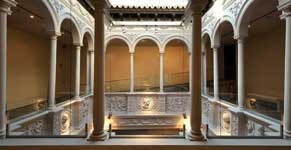The building
The house that is now home to the Goya Museum–Ibercaja Collection originally belonged to the petty noble (infanzón) Jerónimo Cósida and his wife Violante de Albión, representatives of two families of certain rank in the city. Construction on it began in 1535 and would last throughout the year. Juan de Lanuza, a master of Moorish houses, took charge of the works. The building is a good example of the progress that the Renaissance was making in the homes of Zaragoza.
The courtyard is square, presenting ringed columns with fluting at the top, crowned with beautiful Corinthian capitals. The upper gallery, with sober Tuscan columns and half-point arches, preserves the decoration of gypsum grotesques and medallions of the parapet, with images in old taste that enclose a message alluding to the lineage of the house, with a propitious birth (Atia Balba Caesonia, mother of Augustus) in conjunction with a disastrous and markedly improper birth (mother of Marcus Agrippa).
The key to this interpretation is found in the brooch worn on the dress of the woman in the medallion of the parapet on the north side of the courtyard: a child with feet facing forward. This detail characterises the figure as the mother of Agrippa, who was born feet-first rather than head-first. This was considered an unnatural birth, which would cause him and his descendants to lead tormented lives.
There is an image of another female figure on the south side of the courtyard. The adornments that she wears are essential to identifying her child on the west side. Her brooch bears an angel, surely Cupid. A medallion adorning her hair shows a rampant lion, a symbol of Zaragoza since the Middle Ages. This medallion alludes to Augustus, the founder of ancient Caesaraugusta. Likewise, the illustration of the man in the tondo on the west side of the courtyard with a crown of laurels is Augustus.



